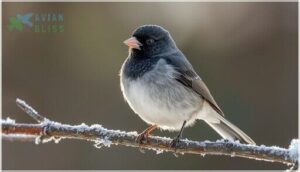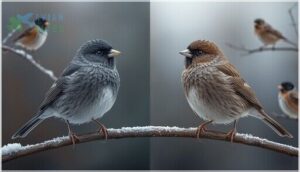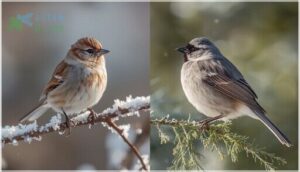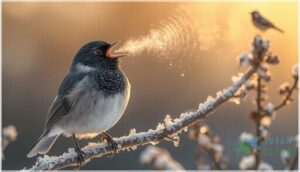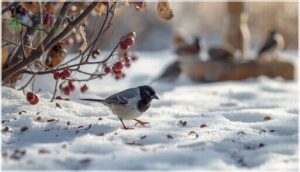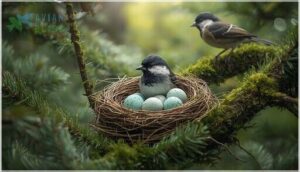This site is supported by our readers. We may earn a commission, at no cost to you, if you purchase through links.

A flash of white tail feathers against winter snow—that’s often your first glimpse of the dark-eyed junco, a small gray bird that earns its “snowbird” nickname by arriving at backyard feeders just as temperatures drop. Despite being one of North America’s most abundant forest birds, with populations stretching from Alaska to Mexico, these sparrow relatives fly under the radar for many observers.
Their unassuming slate-gray plumage and ground-hugging habits make them easy to overlook, yet juncos reveal fascinating variations across regions, from the hooded forms of the Rockies to the pink-sided populations of the northern Plains.
Understanding how to identify these resilient birds, recognize their preferred habitats, and interpret their foraging behaviors can transform casual backyard watching into a deeper appreciation for one of the continent’s most adaptable species.
Table Of Contents
- Key Takeaways
- What is a Dark-eyed Junco?
- How to Identify Dark-eyed Juncos
- Where Do Dark-eyed Juncos Live?
- Dark-eyed Junco Behavior and Diet
- Breeding, Conservation, and Population Status
- Frequently Asked Questions (FAQs)
- Do dark eyed juncos eat seeds?
- What does a dark-eyed junco look like?
- What is a dark-eyed junco (Junco hyemalis)?
- Are dark eyed juncos rare?
- Where can I find dark eyed juncos?
- Where did the dark-eyed junco come from?
- How rare is a Dark-eyed Junco?
- What does it mean when you see a Dark-eyed Junco?
- What is special about juncos?
- Where do juncos sleep at night?
- Conclusion
Key Takeaways
- You’ll recognize dark-eyed juncos by their compact sparrow build, white outer tail feathers that flash during flight, and striking regional variations—from uniform slate-gray eastern birds to black-hooded Oregon forms with rusty backs—all of which freely interbreed despite once being classified as separate species.
- These abundant forest birds employ ground-foraging techniques like distinctive two-footed scratch-feeding through leaf litter and clever “stem riding” to bend grass stalks down, with their diet shifting from 75-90% seeds in winter to nearly 50% insects during breeding season when they feed nestlings almost exclusively caterpillars and spiders.
- Despite numbering around 220 million individuals across North America, dark-eyed juncos have experienced a troubling 40% population decline since 1970—losing roughly 168 million birds at a rate of 0.7% annually—driven by climate change pushing suitable habitat northward, habitat fragmentation, and anthropogenic threats like window strikes and pesticide exposure.
- Winter flocks reveal strict social hierarchies where dominant adult males push females and juveniles farther south, creating geographic segregation patterns, while their migration timing and ground-feeding habits beneath backyard feeders earn them the nickname “snowbirds” throughout much of the eastern United States.
What is a Dark-eyed Junco?
If you’ve spotted a small, gray bird with bright white tail feathers hopping around your backyard, you’ve likely met a Dark-eyed Junco. These neat little sparrows are among North America’s most abundant forest birds, though their appearance can vary quite a bit depending on where you’re.
Let’s look at what defines this species, the different forms you might encounter, and how juncos fit into the broader sparrow family.
Species Overview and Classification
The Dark-eyed Junco (Junco hyemalis) is a sparrow you’ll find across North America, belonging to the Passerellidae family. First described by Carl Linnaeus in 1758, its taxonomic history has been turbulent—what were once separate species merged into one in the 1970s. This junco’s evolutionary relationships trace back roughly 18,000 years, with the genus Junco introduced in 1831. As a result of their migration patterns, they’re often referred to as eastern United States snowbirds.
Key classification details:
- Order: Passeriformes (perching birds)
- Family: Passerellidae (New World sparrows)
- Genus: Junco (from Latin juncus, meaning rush)
- Species: J. hyemalis (the hyemalis origin refers to winter)
- Common names: Junco Ojioscuro (Spanish), Junco ardoisé (French)
Junco Subspecies and Variations
You’ll encounter at least six major regional forms across North America—Slate-colored, Oregon, Pink-sided, Gray-headed, White-winged, and Guadalupe—all united as Junco hyemalis based on plumage genetics and hybrid zones. Despite morphological variation that once suggested separate species, these junco subspecies interbreed freely where ranges overlap. Subspecies identification hinges on distinctive patterns:
| Form | Key Features |
|---|---|
| Slate-colored | Uniform dark gray hood and back; white belly |
| Oregon Junco | Black hood; rusty back and flanks |
| Pink-sided Junco | Pale gray hood; cinnamon-pink sides |
| Gray-headed Junco | Gray overall; rufous back patch (Red-backed) |
| White-winged | Bold white wingbars; extensive tail white |
| Guadalupe | Island endemic; restricted to Baja California |
Their evolutionary history reveals stable populations of Oregon × Slate-colored hybrids (Cassiar Juncos), confirming extensive gene flow despite striking color differences. These birds are commonly found within coniferous and deciduous forests across North America.
Relationship to Other Sparrows
Beyond those subspecies boundaries, you’ll find dark-eyed juncos sharing evolutionary history and habitats with dozens of New World sparrow species in the family Passerellidae. Their closest relatives include Zonotrichia and Melospiza sparrows, with whom they compete at feeders and overlap in niche. Rare hybridization events with song sparrows confirm weak reproductive barriers, though foraging behavior differences—juncos prefer ground level—reduce direct feeder competition among Passeriformes.
Shared traits with other sparrows:
- Ground-foraging preference for fallen seed
- Three-quarters seed-based annual diet
- Mixed winter flocks at backyard feeders
- Seasonal insect consumption during breeding
- Similar skull morphology within Passerellidae
How to Identify Dark-eyed Juncos
You can recognize a dark-eyed junco by its neat, compact build and those unmistakable white outer tail feathers that flash when it takes off.
These little sparrows show surprising variety in their plumage depending on where you spot them, and males, females, and juveniles each have their own look.
Let’s break down what to watch for so you can confidently identify these common visitors.
Key Physical Characteristics
You’ll spot a Dark-eyed Junco by its neat, compact frame—roughly 5 to 7 inches long with a wingspan near 7 to 10 inches. Look for that short, stout, pale pink bill built for cracking seeds, and those trademark dark eyes that give the bird its name. The white belly and vivid white outer tail feathers flash like tiny flags when it takes flight.
| Feature | Description |
|---|---|
| Body Size | 5.1–6.9 inches long; 0.63–1.06 oz |
| Bill | Short, conical, pale pink to pinkish-white |
| Eyes | Uniformly dark brown to nearly black |
| Tail Pattern | White outer feathers, dark central feathers |
Plumage Differences by Region and Sex
Male juncos consistently show darker, richer plumage than females across all forms. In the East, you’ll find slate-gray males contrasted with paler, browner females. Out West, Oregon males sport black hoods and chestnut backs, while females display softer grays and muted browns.
Hybrid zones blur these patterns where ranges overlap, and migration further shuffles regional color variations and sexual dimorphism into mixed winter flocks.
Juvenile Vs. Adult Appearance
You can tell juveniles from adults by their streaky brown plumage and narrow, tapered tail shape. Watch for brownish wing molt limits where old and new feathers meet—adults show uniform gray coverts instead.
Juveniles also have darker bills and iris color early on, gradually lightening with age. These physical characteristics and color variations help you age juncos in the field with confidence.
Songs and Calls
How do you recognize Junco vocalizations and sounds in the field? Listen for trill-based songs and calls that vary by context and season. Males generally master about 4 song types through song learning, repeating one up to 120 times before switching.
Key Dark-eyed Junco songs and calls include:
- Long-range territorial songs – broadcast from treetops during breeding season
- Short-range courtship songs – quieter, used near mates
- Rapid aggressive songs – faster delivery during chases
Seasonal singing peaks in summer, while urban adaptation has shifted acoustic performance toward higher frequencies in noisy environments. Each male’s song repertoire reflects both learned patterns and improvisation.
Where Do Dark-eyed Juncos Live?
Dark-eyed juncos don’t stay put year-round—they’re on the move depending on the season. You’ll find them in different parts of North America throughout the year, from snowy mountain forests in summer to your backyard feeders in winter.
Let’s look at where these little sparrows spend their time and what kinds of places they call home.
Year-Round Distribution
You’ll find Dark-eyed Juncos across nearly the entire continent—from Alaska to Mexico—demonstrating considerable continental presence throughout the year. Their geographic distribution includes resident populations in the Pacific Northwest and Appalachians, while altitudinal migration patterns move western birds between high-elevation breeding zones and lower winter habitat.
This habitat continuity, combined with seasonal abundance peaks and overlapping ranges, means you can encounter these adaptable sparrows somewhere in North America during any season.
Breeding and Winter Ranges
You’ll observe breeding grounds from late May through August spanning Alaska to Newfoundland and south through the Appalachians, with Oregon subspecies nesting along Pacific Coast Ranges.
During winter habitat occupancy from December to February, these migration patterns shift southward—slate-colored birds reach northern Florida while Oregon forms move to the Great Plains.
Climate change and range expansion are gradually pushing this geographic distribution northward, with subspecies overlap occurring in winter flocks.
Preferred Habitats and Environments
You’ll find dark-eyed juncos thriving where forest edge meets clearing—they avoid dense, closed-canopy interiors. These bird species occupy woodland edges, brushy borders, and stream margins from sea level to 3,500 meters along elevational gradients.
Urban adaptation allows flocks in suburban yards with protective cover.
Habitat disturbance from logging or beetle outbreaks actually increases local abundance, while climate impacts push suitable dark-eyed junco habitat northward as treeline advances.
Dark-eyed Junco Behavior and Diet
If you’ve spotted a junco hopping around your yard, you might wonder what it’s up to and what it’s looking for. These little birds have some fascinating habits in how they find food and interact with others.
Let’s look at how dark-eyed juncos spend their days, what they eat, and how you can welcome them to your backyard.
Foraging and Feeding Habits
You’ll spot Dark-eyed Juncos hopping across the ground—they don’t walk—using both feet in a distinctive “scratch-feeding” motion through leaf litter. Their ground foraging centers on seeds (75% of their annual diet), though breeding season shifts toward insects for protein.
Watch for their clever “stem riding” behavior: they’ll grip tall grass stems, bending them down to reach seed heads. Habitat selection balances open feeding areas with nearby cover for quick escapes.
Social and Flocking Behavior
While juncos forage solo during breeding season, you’ll encounter them in winter flocks of 15–25 birds sharing 10–12 acre territories. These groups reveal strict social behavior: adult males dominate the pecking order, pushing females farther south and creating winter segregation patterns. Flocking offers predator avoidance through collective vigilance—when one bird spots danger, the entire group retreats to cover.
Key aspects of Junco social behavior:
- Flock dominance hierarchy: Larger males outrank females and juveniles, controlling feeding access
- Mixed flocks advantage: Winter groups often include other sparrows, multiplying alert eyes
- Social shifts seasonally: Territorial pairs in summer transform into cooperative winter aggregations
Diet Throughout The Year
Throughout the year, you’ll witness a striking seasonal diet shift in these seed eaters. Winter seed diet relies on 80–90% plant matter—chickweed, lamb’s quarters, and millet dominate.
Come breeding season, breeding insect intake jumps to nearly 50% of adult consumption, with nestlings fed almost exclusively caterpillars and spiders.
This annual diet composition tracks food availability, supporting the junco’s considerable abundance across North America.
Backyard and Feeder Preferences
You’ll draw these feeder birds to your yard most effectively by meeting their ground-foraging instincts. Backyard birding success with Dark-eyed Juncos depends on smart feeder placement and thoughtful habitat design.
- Feeder placement: Position low platform feeders within 2–5 m of dense shrubs or conifers—vegetation cover directly influences their willingness to feed.
- Seed preferences: Offer white proso millet, cracked corn, or hulled sunflower chips in open trays.
- Seasonal use: Expect peak bird feeding activity during snow cover and cold snaps when natural seeds become inaccessible.
- Feeder safety: Clean spilled seed regularly and place feeders where cats can’t ambush your visitors.
Breeding, Conservation, and Population Status
Dark-eyed juncos are remarkably successful breeders, with females laying three to five eggs that hatch in less than two weeks. Their population stands at an impressive 220 million mature individuals across North America, making them one of the continent’s most abundant forest birds.
Here’s what you need to know about their breeding habits, population health, and some surprising facts that make these little sparrows so special.
Nesting and Reproduction Habits
You’ll find Dark-eyed Junco nests tucked on the ground beneath grasses or roots, though urban pairs sometimes build up to eight feet high.
Each breeding season brings 3–6 eggs per clutch, usually across 2–3 broods from April onward. Females handle the 12-day incubation period while males guard territory, then both parents deliver insects to nestlings until they fledge around 10–13 days later.
Population Size and Trends
You’ll encounter Dark-eyed Juncos across a vast continental distribution—global estimates place their population near 220 million individuals, making them one of North America’s most abundant forest birds. Yet relative abundance masks a troubling population decline:
Dark-eyed Juncos number 220 million across North America, yet their abundance conceals a troubling 40% regional decline
- Breeding Bird Survey data show roughly 168 million juncos lost since 1970
- Continental numbers dropped about 0.7% annually between 1966 and 2019
- Regional variations reveal steeper declines in boreal intermediate zones
- Climate change threats to birds compound habitat pressures despite stable IUCN Status
Conservation Status and Threats
Despite their “Least Concern” IUCN Status, you’re witnessing climate change, habitat loss, and fragmentation erode junco numbers across North America—a population decline exceeding 40% regionally.
Anthropogenic threats include window strikes, cat predation, and pesticide exposure. Climate impacts shift suitable breeding zones northward, compounding habitat fragmentation from urbanization and deforestation.
Conservation efforts now target habitat protection, feeder hygiene, and reducing collision risks to stabilize Dark-eyed Junco conservation status.
Fun and Unique Facts
You’ll often hear juncos called “snowbirds”—apt, given their winter coping strategies and migration patterns that bring them south in droves. Urban adaptation has turned some populations into year-round city dwellers, raising up to four broods annually at UC San Diego.
Social hierarchies split winter flocks by sex, while mating systems feature frequent extra-pair pairings. Ground nesting success varies wildly—85% of attempts sometimes fail to predators.
Frequently Asked Questions (FAQs)
Do dark eyed juncos eat seeds?
Yes, seeds dominate the Dark-eyed Junco diet—about 75% year-round. You’ll spot them hopping beneath feeders, scratching through leaves for wild seeds like millet, chickweed, and grass seeds, especially during winter months.
What does a dark-eyed junco look like?
You’ll spot a compact sparrow measuring about 6 inches with striking white outer tail feathers. Regional forms show dramatic color variations—from slate-gray to black-hooded with chestnut backs—but all display crisp, two-toned plumage patterns.
What is a dark-eyed junco (Junco hyemalis)?
Like a spark in winter’s gray canvas, the dark-eyed junco (Junco hyemalis) is North America’s most abundant forest sparrow—a New World Passerellidae member with striking regional plumage variations and widespread distribution.
Are dark eyed juncos rare?
Dark-eyed Juncos aren’t rare at all—they’re one of North America’s most abundant birds, with population abundance estimated at 220-630 million individuals.
However, regional variations and habitat loss from climate impact warrant continued monitoring.
Where can I find dark eyed juncos?
Think of them as forest ghosts that haunt your feeder in winter.
You’ll spot Dark-eyed Juncos under backyard feeders, along woodland edges, and in shrubby thickets from late fall through early spring across most of North America.
Where did the dark-eyed junco come from?
You’re looking at a bird that evolved from Mesoamerican yellow-eyed junco ancestors through rapid postglacial expansion northward after ice sheets retreated.
This diversification occurred over roughly 10,000–18,000 years, resulting in today’s morphotype subspecies across urban and wild habitats.
How rare is a Dark-eyed Junco?
You’ll spot these birds regularly—they’re one of North America’s most abundant songbirds, with populations exceeding 200 million despite a 42% decline since Regional variations and seasonal abundance affect local sightings.
What does it mean when you see a Dark-eyed Junco?
Spotting a bird with stark contrasting plumage often signals seasonal change and inner reflection. When you observe a Dark-eyed Junco, it’s considered a spiritual messenger—a balance symbol offering guidance and marking winter’s arrival.
What is special about juncos?
Juncos show considerable plumage variation across subspecies and serve as model species in evolutionary studies. They also demonstrate foraging innovations, such as stem riding.
Their climate sensitivity and urban adaptation make them invaluable indicators of environmental change.
Where do juncos sleep at night?
You’ll find most Dark-eyed Juncos choosing roost sites in dense evergreens or thick brush piles when night falls.
They don’t sleep in nests outside breeding season, preferring sheltered microclimate benefits that reduce winter survival energy costs.
Conclusion
Once you’ve trained your eye to catch that telltale tail flash, you’ll wonder how you ever missed them—dark-eyed juncos are everywhere.
These unassuming winter companions transform ordinary feeders into hubs of activity, their industrious ground-scratching and regional plumage variations offering endless discovery.
Whether you’re tracking slate-colored birds in the East or hooded forms out West, juncos prove that abundance doesn’t mean ordinary. Their resilience and adaptability make every sighting worth celebrating.
- https://www.borealbirds.org/bird/dark-eyed-junco
- https://holdenfg.org/nature-profiles/dark-eyed-junco/
- https://www.birdful.org/where-do-dark-eyed-juncos-migrate-to/
- https://www.allaboutbirds.org/guide/Dark-eyed_Junco/overview
- https://www.frontiersin.org/journals/bird-science/articles/10.3389/fbirs.2024.1417867/full

